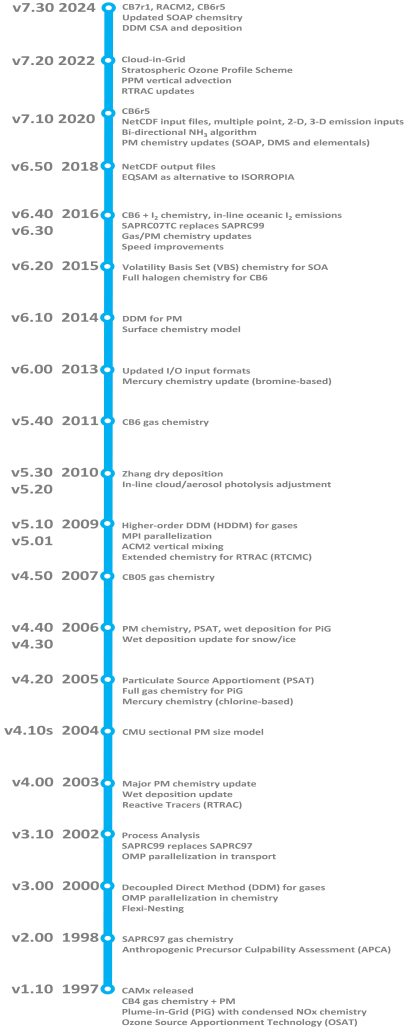CAMx is a state-of-the-science photochemical grid model that comprises a “one-atmosphere” treatment of tropospheric air pollution over spatial scales ranging from neighborhoods to continents. It is an open-source system that is computationally efficient, flexible, and available at zero cost. Meteorological inputs are supplied to CAMx from separate weather prediction models (e.g, WRF). Emission inputs are supplied from external pre-processing systems (e.g., SMOKE and EPS3).
Version 7.31 replaces version 7.30 with some bug fixes. Version 7.30 offers expanded capabilities over previous versions. Detailed information about all of these features is provided in the CAMx User’s Guide (pdf).
In addition to the features it shares with other photochemical grid models, the most notable features of CAMx are:
- Flexible two-way grid nesting on many map projections
- Multiple gas phase chemistry mechanism options (CB6/7, RACM2, SAPRC07)
- Advanced external photolysis model (TUV) with in-line cloud and aerosol adjustments
- Comprehensive aerosol chemistry with a modal size treatment
- Plume-in-Grid (PiG) module for sub-grid treatment of selected point sources
- Multiple dry deposition options (Wesely89, Zhang03)
- Bi-directional surface ammonia treatment
- Surface chemistry / re-emission model
- Cloud-in-Grid convective mixing model
- Stratospheric Ozone Profile scheme for hemispheric applications
- Probing Tools:
- Ozone and Particulate Source Apportionment Technology (OSAT/PSAT)
- Decoupled Direct Method (DDM/HDDM) for source sensitivity of ozone, PM and other species
- Multiple Process Analysis (PA) options
- Reactive Tracer treatment (RTRAC/RTCMC) for air toxics
- Mass conservative and consistent transport numerics:
- Multiple advection solvers (PPM, Bott, implicit hybrid vertical scheme)
- Multiple vertical diffusion methods (K-theory, ACM2)
- Parallel processing using Open Multi-Processor (OMP) on shared-memory systems
- Parallel processing using Message Passing Interface (MPI) on distributed-memory systems
CAMx Applications Worldwide
Since 1996, CAMx has been employed extensively by local, state, regional, and federal government agencies, academic and research institutions, and private consultants for regulatory assessments and general research throughout the U.S. and the world. CAMx has been used in more than 20 countries on nearly every continent (noted in blue in the map below).

Development Timeline

